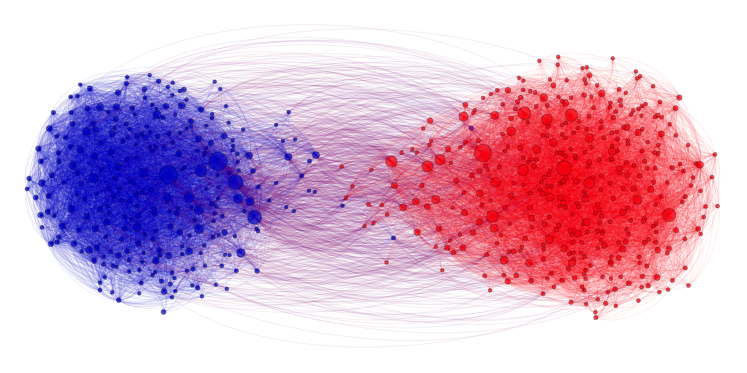Visualizing Polarization in Political Blogs
09 Oct 2014Data Set
This dataset was created in 2004 by Lada Adamic. I had the privilege of taking an online social network analysis course from her on Coursera. For those looking to gain a good understanding of that field, the course just barely started up again. I highly recommend it.
This graph contains 1,490 blogs and 19,025 links between them. To focus in on the more prominent blogs, I filtered out blogs which have less than 12 links either to or from them. After filtering, there are 665 blogs and 16,852 links between them.
Simple Analysis
I wanted to do a simple analysis on this as compared to some of my other posts. What's most interesting about this dataset is that the polarization and echo-chambers of the US political blogosphere jump right out at you when you do a simple layout and community detection. I used a Force-directed layout and then colored the two emerging communities blue and red for liberal and conservative respectively.

Here's an svg version.
Animated Visualization
What's interesting to watch is the force-directed layout separating these two communities from an initial random positioning. To do this, I detected the communities and colored them as described above. I then had Gephi do a random layout. Finally, I tuned Gephi's Force Atlas force-directed layout to operate more slowly and ran it to see the two communities separate from each other. After a few takes (to get the communities to emerge left and right), I was able to produce this:
(for full-screen HD, view on vimeo.com)
I spend a few moments at the end highlighting different blogs that are within, between, and on the outskirts of each community.
Musings
What I find that really resonates with me in this visualization is the intuition many people have of what this represents. For all the tools and technologies that we have that can connect us to each other, there often seems to be a separation or isolation that occurs. This has been called out in observations like online filter bubbles, the big sort, and an insightful NYTimes opinion piece by Charles M. Blow.
While we should value and respect differences in a pluralistic society like the US (or the world in general), an over-emphasis on these differences or always seeing them as something negative to be avoided leads to strained relationships, neighborhoods, nations, and people.
I think this quote by Rumi provides a kind of antidote for some of these trends:
Out beyond ideas of right and wrong, there is a field. I'll meet you there.
A mark of a mentally agile mind is one that can place their world views on a bookshelf for a moment, walk out into this field, and connect with someone for no other reason than to understand that person. In other words: empathy and humility. It's an extremely gratifying experience. Even if you walk back to your bookshelf and pick right back up where you were before, you've expanded your humanity and perhaps have made a positive impact on that person you've just met. And this kind of expansive, empathetic thinking isn't possible when we're hyper-focused on polarization, filters, dogmatism, and adversarialism.
Often the health of a system network is measured in it's well-connectedness. And when it comes to the positive relationships we cultivate (even with those we might disagree) this very much applies.
 AllThingsGraphed.com
AllThingsGraphed.com